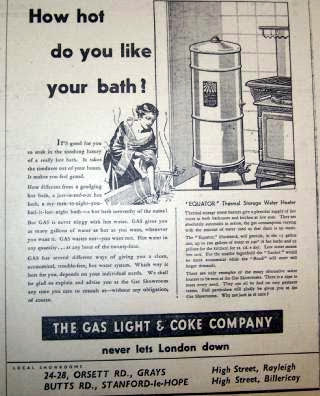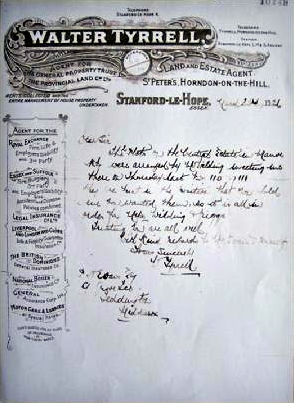Utilities
With the exception of mains water which was supplied by the South Essex Water Company from the ample supplies in the Grays chalk pits area, prior to the 20th century residents in Stanford as elsewhere had no access to the utilities we take for granted today. As we mentioned previously most houses had no separate bathrooms and bungalow baths were used that had to laboriously filled by hand with hot water obtained from a coal boiler.
By the early 20th century some main drainage facilities had been provided, but other dwellings had cess pits that had to be emptied into carts by workers known as nightmen which then had to travel through residential areas. With an expanding population that had grown to 2190 by 1909, a proper main drainage scheme was becoming a necessity.
The provision of such drainage to the rest of the area and the enlargement and modernisation of the main sewage works, was planned as part of a major scheme for which discussions between the parish councils of Stanford; Mucking; and Horndon with the Orsett Union began in 1909. As we have seen the original boundaries of these parishes were at the bridge over the Hassing Brook in London Road and the north side of London Road. This had led to some anomalies over time as for instance Stanford railway station lay partly both in the parishes of Mucking and Horndon but not Stanford. As some of the first beneficiaries of a new sewerage scheme would be the residents of the Little Butts estate in London Road in the Parish of Mucking, it was decided that it would best be handled by the one most involved which was Stanford. The boundary of the Stanford parish was therefore enlarged in an agreement of 1910 by transferring some acreages of land from the Mucking and Horndon Parishes to Stanford Parish. After much delay in obtaining the funds for the scheme caused partly by the late addition of the Balstonia estate it finally went ahead in 1912-13.
In 1898 a company was incorporated to supply Stanford with gas and capital raised to construct a works but the scheme was abandoned and the capital returned to the investors. A rival scheme to bring electricity to the parish proposed by an electrician who settled in the village attracted much interest and he obtained a contract with the parish council to proceed, however his backer, Mr. Morley Hill, failed to provide any financing with the result that the scheme foundered and the electrician disappeared. Stanford village accordingly remained unlit in the winter months until a few oil lamps were installed which were used from 1st September each year. The main parish lamp stood on The Green at the site of the now War Memorial.
The scheme to provide a gas works was revived in 1905 but construction did not begin until 1908 with the plant opening in Butts Road on September 7th 1909. The new company was awarded a contract with the parish council to provide 80 Bray’s Incandescent upright burners which were ceremonially bought into use on the opening day.
The Stanford Gas company remained independent until 1913 when it was taken over by the Grays and Tilbury Gas Company. The Grays and Tilbury was a pioneer of what was then high pressure gas transmission at 50psi (about 3.4 bar) and supplied gas by pipeline from their works in London Road Grays to the offtake in Butts Road with the original gas manufacturing works there subsequently being closed. They also supplied areas of Laindon, Billericay; and Rayleigh.
The Grays and Tilbury Gas Company was in turn absorbed by the much larger Gas Light and Coke Company in 1930 along with another local undertaking in Pinner, Middlesex. The Gas Light and Coke continued to expand through Essex during the 1930s and at the time of nationalisation after the Second World War formed the North Thames Gas Region of the British Gas Corporation, The Butts Road site is still the location of a gas pressure reduction station.
When an electrical supply was finally made available in Stanford by the County of London Electric Supply Company, as was usual in rural locations in the early days of electrical distribution the power was, and still is in some roads, supplied by an overhead system supported by wooden poles. In the early 1930’s the company declined to connect the Balstonia estate because it would need to be supplied using expensive trenching for underground cables since the number of trees meant that an overhead system was not possible.
Telephone services were provided by the Post Office but were are rarity in private houses and many businesses in the area prior to the 1950s. Above is the ornate letterhead of Walter Tyrell land and estate agent of St.Peter’s Horndon-on-the-Hill who was graced with the telephone number of Stanford-le-Hope 4.

